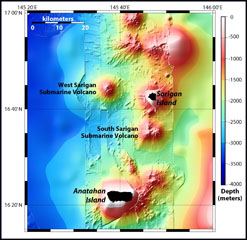Report on South Sarigan Seamount (United States) — 26 May-1 June 2010
Smithsonian Institution / US Geological Survey
Weekly Volcanic Activity Report, 26 May-1 June 2010
Managing Editor: Sally Sennert.
Please cite this report as:
Global Volcanism Program, 2010. Report on South Sarigan Seamount (United States) (Sennert, S, ed.). Weekly Volcanic Activity Report, 26 May-1 June 2010. Smithsonian Institution and US Geological Survey.
South Sarigan Seamount
United States
16.58°N, 145.78°E; summit elev. -184 m
All times are local (unless otherwise noted)
On 27 May an observer from the Emergency Management Office (EMO) in Saipan photographed an area of discolored ocean water and possible light-colored floating material about 7 km S of Sarigan during an overflight. The area was about 1.6 km long, although the scale was difficult to discern from photographs. Two days later, the area of affected water was about twice the size of Sarigan Island. According to a news article, U.S. Fish and Wildlife evacuated 16 people, mostly scientists, to Saipan from a few area islands, including eight people from Sarigan.
On 30 May a plume of mostly water vapor was seen in satellite imagery rising to a possible altitude of 12.2 km (40,000 ft) a.s.l. and dissipating as it drifted S. The eruption was attributed to a 300-m-deep submarine vent on Sarigan's S flank, about 7 km from the island. Observers on Sarigan reported hearing a loud explosion from the S, and shortly thereafter received ashfall. The Volcano Alert Level was raised to Watch and the Aviation Color Code was raised to Orange. Both seismicity at a single nearby station on Sarigan and subaqueous activity declined after the plume emission. The next day the Volcano Alert Level was reduced to Advisory and the Aviation Color Code was reduced to Yellow.
Geological Summary. South Sarigan seamount, rising to within about 184 m of the ocean surface 12 km S of Sarigan Island, was the site of a short explosive submarine eruption in May 2010 that produced a plume of ash and steam to 12 km altitude. Sidescan sonar imagery taken in 2003 shows an irregular summit with multiple peaks, including a possibly young cone at about 350 m depth, and flank morphology suggests it is a frequently active volcano.
Sources: Emergency Management Office of the Commonwealth of the Mariana Islands and United States Geological Survey Volcano Hazards Program, Saipan Tribune

